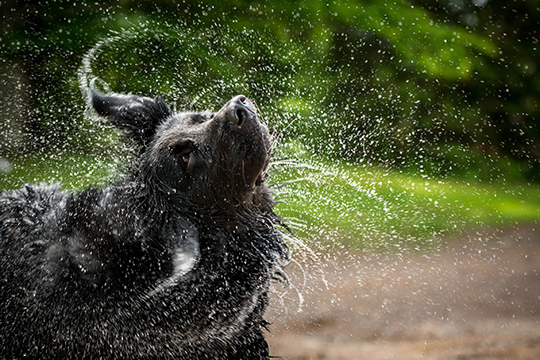Dealing With Dog Hair in Your AquaPaws – Part 2

Because exercising animals in your AquaPaws underwater treadmill always causes a continuous supply of hair, it is an ongoing battle of maintenance. In Part 1 of Dealing with Dog Hair, we discussed that “one dog equals 20 people bathing in water” and how that puts perspective into reality. While excessive hair in your unit can cause issues and delays, and be unsightly, it does not impair the water quality. With proper water balancing and sanitizer levels, along with regular cleaning techniques, dealing with animal hair can be easily manageable.
Although we may never get rid of all the hair, I have some helpful tips to keep hair from accumulating in large quantities in the water storage tank.
After exercising animals or breeds that shed a lot, the hand skimmer should be run through the water on each side of the patient, back and forth a couple times as you begin draining. This only takes a few seconds as you begin to wait for the exercise chamber to drain.
At the end of each day, the recirculation system is recommended to run a minimum three hours after the last patient of the day. This allows the filter to clear the water from the day’s activity and will remove a large portion of hair floating throughout the water. This is evident by the amount of hair the filter collects. Keep an eye on the filter gauge pressure. Only change the filter when the gauge reads 10 psi over the starting pressure of a clean filter. New filters typically start at 6 to 8 psi and cleaned reused filters typically start at 10 to 12 psi. So, I advise clients to change new filter cartridges when the gauge reads 16 to 18 psi and clean reused cartridges around 20 psi. Don’t forget to make sure your gauge starts at true zero when the system is off.
And lastly, a freshwater drain and refill is recommended every week to two weeks, depending on patient numbers or bather load. Your AquaPaws comes standard with a 2” drain line with a shut-off valve directly from the water storage tank to the waste drain. All systems are marked with a green sticker “water storage drain to waste.” The process for a freshwater drain and refill is easy. With the system shut down at the disconnect panel, the storage waste drain is opened and the water gravity drains. I always advise clients to set a stopwatch and time how long it takes to empty the water storage tank so next time you go through the process you can set an alarm and save valuable time (you don’t have to watch and wait for it to drain). With the valve still open, use your fill hose to rinse any hair off the sides of the tank and out the drain. All the hair may not go down the drain swiftly but a large portion can be flushed out the drain with running water. We work with animals, so there will always be some hair after rinsing, but this regular maintenance will make a big difference.
If the drain clogs with hair during draining, don’t be alarmed. Shut the storage-to-waste drain valve and fill the tank up halfway. Reopen the storage-to-waste valve and the extra weight of the water will push the clog through the drain pipe and out the drain. Don’t forget to clean the grate on your floor drain when finished.
If you notice any additional hair on the top of the water in your storage tank after a freshwater drain and refill, a small net skimmer can be used to skim any leftover hair. Also, running the recirculation as you heat the water to rehab temperature will filter most residual hair left after a freshwater drain and refill.
Hair will always be an issue but staying on top of removal as it accumulates is the key to being efficient and avoiding costly down time.